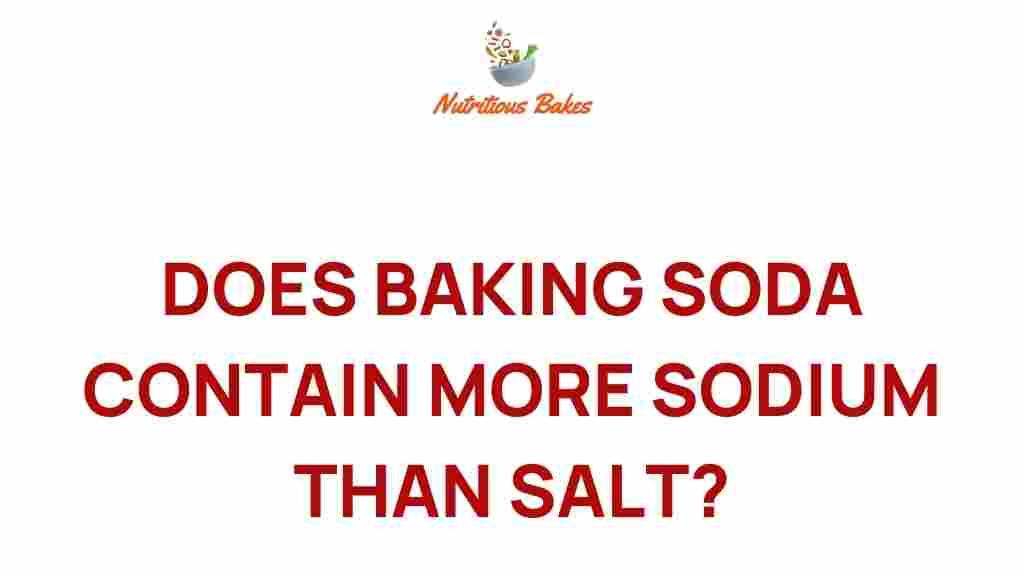Unveiling the Sodium Secrets: Is Baking Soda Saltier than Salt?
When it comes to cooking and baking, the ingredients we use can significantly affect the flavor, texture, and overall success of our culinary creations. Among these ingredients, baking soda and salt are staples found in most kitchens. While they may seem similar, their properties and uses are quite different. In this article, we will delve into the sodium content of baking soda compared to salt, explore their culinary uses, and provide health insights that can help you make informed decisions in the kitchen.
Understanding Sodium Content
Sodium is an essential mineral that plays a crucial role in maintaining fluid balance, nerve function, and muscle contraction. However, excessive sodium intake can lead to health issues such as high blood pressure and cardiovascular disease. Therefore, understanding the sodium content in common kitchen ingredients is vital.
- Baking Soda: The chemical name for baking soda is sodium bicarbonate (NaHCO₃). It contains about 27.3% sodium by weight.
- Salt: Common table salt, or sodium chloride (NaCl), consists of about 39.3% sodium by weight.
This means that while baking soda contains sodium, it is less salty than salt when compared by weight. However, the taste and functionality in recipes can vary greatly.
Salt Comparison: Flavor and Functionality
Salt is primarily used to enhance flavor and preserve food. It has a strong, salty taste that can overpower other flavors if used excessively. In contrast, baking soda is primarily used as a leavening agent in baking. It reacts with acidic ingredients to produce carbon dioxide, which helps dough rise.
Let’s break down the key differences:
- Flavor: Salt is salty and enhances flavors, while baking soda is slightly alkaline and has a neutral to slightly salty flavor.
- Function: Salt is a flavor enhancer and preservative; baking soda is a leavening agent.
- Health Considerations: Both should be used in moderation, but the health implications of high salt intake are more pronounced than those of baking soda.
Culinary Uses of Baking Soda
Baking soda is an incredibly versatile ingredient in the kitchen. Here are some of its primary culinary uses:
- Leavening Agent: Baking soda is often used in recipes for cookies, cakes, and pancakes. When combined with an acid, it releases carbon dioxide, helping baked goods rise.
- Tenderizing Meat: A small amount of baking soda can be used to tenderize meat, making it more palatable.
- Neutralizing Acidity: Baking soda can help neutralize the acidity in dishes, making it useful in recipes that include tomatoes or vinegar.
- Brightening Vegetables: A pinch of baking soda in boiling water can help keep vegetables bright and colorful.
Health Insights: Baking Soda vs. Salt
When considering the health implications of these two ingredients, it’s essential to understand their sodium content and potential effects on the body:
- High Sodium Intake: Excessive consumption of salt can lead to hypertension and other cardiovascular issues. It is crucial to monitor daily sodium intake.
- Baking Soda Usage: While baking soda is generally safe, excessive consumption can lead to sodium overload and alkalosis, a condition where the body’s pH becomes too alkaline.
- Moderation is Key: Both ingredients should be used sparingly. While baking soda is less salty, it can still contribute to your overall sodium intake.
Cooking Tips for Using Baking Soda
Here are some practical cooking tips to effectively use baking soda in your kitchen:
- Measure Accurately: Use a proper measuring spoon for accuracy. Too much baking soda can lead to a soapy taste in baked goods.
- Combine with Acid: To activate its leavening properties, always combine baking soda with an acidic component (like vinegar, yogurt, or lemon juice).
- Freshness Check: Ensure your baking soda is fresh. You can test it by adding a teaspoon to vinegar; it should fizz vigorously if it’s still active.
- Use in Moderation: When tenderizing meat, use a small amount and rinse thoroughly before cooking to avoid an off flavor.
Ingredient Analysis: The Science Behind Baking Soda
The science of baking soda is fascinating. It’s a chemical compound that, when heated or mixed with an acid, undergoes a reaction that produces carbon dioxide gas. This reaction is what makes baked goods rise and become fluffy. Understanding this reaction can help you troubleshoot common baking issues, such as dense or flat cookies.
Troubleshooting Tips for Baking with Baking Soda
If you encounter problems while baking with baking soda, consider the following troubleshooting tips:
- Flat Baked Goods: Ensure you used enough acid to activate the baking soda. If the acid is too little, the leavening effect will be minimal.
- Soapy Taste: Using too much baking soda can leave a soapy flavor. Stick to the recipe’s measurements.
- Dark Color: Baked goods can turn darker than expected if baking soda is overused, especially in high-sugar recipes.
Conclusion: The Takeaway on Baking Soda and Salt
In conclusion, while both baking soda and salt are essential ingredients in cooking and baking, they serve different purposes and have distinct sodium contents. Baking soda is less salty than salt but plays a crucial role as a leavening agent and a versatile kitchen staple. Understanding their differences allows you to use them effectively in your culinary endeavors.
Remember, moderation is key. Both baking soda and salt should be used wisely to enhance your dishes without compromising your health. Whether you’re baking a cake or seasoning your favorite dish, being informed about your ingredients is the first step towards culinary success.
For more insights into cooking and ingredient analysis, feel free to check out our cooking tips page. If you’re interested in further exploration of food science and nutrition, visit Nutrition.gov for more information.
This article is in the category Ingredients and created by NutritiousBakes Team
